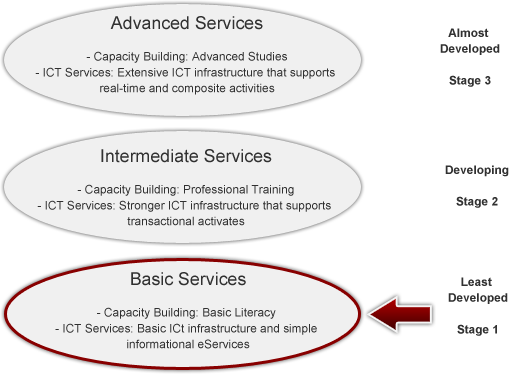|
|||

The following table shows a more detailed view of the services needed to support the three stages. in terms of the eNabler capabilities.
| Service Types | Stage 1 |
| Capacity Building Services Needed | Basic ICT literacy training (e.g., using the Internet, email, word processing) |
| Learning Capabilities Needed | MDG Matrix, Meta Portal |
| ICT services | Basic Internet Access |
| Vertical services (informational) | Entrepreneurial, education, health |
| Vertical services (transactional) | |
| Composite services (Horizontal) | |
| Administrative Services (Funding, Capacity building, Awareness) | Funding Capacity building |
Legend: Yellow indicates the Repositories
Support Needed Orange indicates Planner Capabilities Needed
| You should rely heavily on good (smart) people and processes to compensate for lack of smart technologies |
|
|||
Selected Services
| Services | Status | Actions |
| Found | View it | |
| Not found | ||
| Not found | ||
| Found | View it | |
| Not found |
Decision Table
| Avoid | Investigate |
| None yet | None yet |
| Don't care | Must-do |
| None yet |
Administrative Services / Business Intelligence (BI) Service* Agriculture / Food Distribution in Supply Chains* Economic Development / Customer Services* Education / Distance Learning Transportation and Logistics / Logistics Services |
RECOMMENDED STRATEGY Should be Done Whenever Possible |
||||||||||||||||||||||||||||||||||||||||||||||||||||||||
|
||||||||||||||||||||||||||||||||||||||||||||||||||||||||||||||||||||||||||||||||||||
|
|||
Financial Resource Planner
The detailed plans generated by the Planner, especially the Consolidated Report, can be used to support applications for financial support. Financing of government projects consists of three major sources:
Loans: Many organizations give loans to developing countries. Here is a list:
- World Bank
- Islamic Bank
- International Monetary Fund
- www.globalclearinghouse.org - clearing house for financial aid
- http://www.kiva.org/
- Other sources (loans for developing countries)??
Aid: Developing countries can receive aid from several organizations such as the following:
- Aid Management Program (http://www.developmentgateway.org/programs/amp/) A very good side for aid
- UNICEF
- UNESCO
- USAID (www.usaid.org)
- Others??
Internal Investment: Many countries invest their own revenues to support important development projects. Guidelines are typically published by the said governments for investment proposals.
Public Awareness
A variety of approaches, such as the following, can be used for marketing and public awareness:
- Door to Door
- Media (newspapers, radio, TV, text messages, web advertising)
- Mobile van (around city, weekly advertisements)
- Competitions (in colleges and schools to raise awareness and extract good ides)
Capacity Building:
According to Wikipedia, Capacity building often refers to strengthening the skills, competencies and abilities of people and communities in developing societies so they can overcome the causes of their exclusion and suffering. Typical capabilities typically include:
- Business strategies and processes
- Applications and services needed to support the business strategies and processes
- Computing platforms
- Networks
- Security of all of the above
- Customer support of all the above
Depending on the scope of the initiative, different capabilities from this list may be needed and thus may impact staff needed to support the initiative.
Cloud computing and outsourcing can greatly reduce the staff and training needed (human resources) to develop, offer and support services.